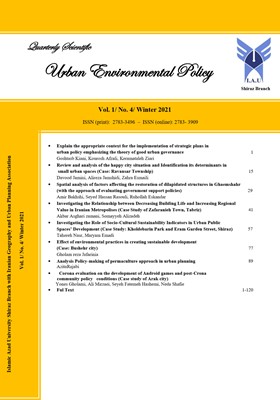Spatial analysis of factors affecting the restoration of dilapidated structures in Ghaemshahr (with the approach of evaluating government support policies)
Subject Areas : Sustainable urban development
Amir Bakhshi
1
,
seyed hassan rasouli
2
![]() ,
rohollah eskandary
3
,
rohollah eskandary
3
1 - Assistant Professor, Department of Geography, Payame Noor University, Tehran, Iran
2 - PhD Student, Geography and Urban Planning, Islamic Azad University, Central Tehran Branch, Iran
3 - M.Sc., Geography and Urban Planning, Payame Noor University of Tehran, Iran
Keywords: Worn Tissue, Supportive Policy, GIS, AHP, Ghaemshahr,
Abstract :
The central and old texture of cities, which were once the most important and best residential neighborhoods of cities and due to the presence of human communities today have many historical and memorable elements, has now suffered from inefficiency. Rehabilitation of worn-out structures can enhance the physical value and increase the desire of citizens to live in it. In this research, which is a survey that is done as a branch of descriptive research, statistical block tools and burnout articles and books, which is the most reliable data collection tool, have been used to collect information. Investigation of environmental system and appropriate indicators to identify urban worn-out textures using planning models (ahp) Neighborhoods have been introduced as worn-out textures. These indices including fineness, instability and impermeability in the textures of Ghaemshahr city have been refined and studied and each of them has been considered as a criterion for approaching worn-out urban textures. Worn-outs have been identified and introduced, and as a result, by supporting the indicators for improving and renovating these tissues, the necessary suggestions have been made to eliminate and prevent the non-worn tissues from being produced.Extended AbstractIntroduction: The central and old texture of cities, which were once the most important and best residential neighborhoods of cities and due to the presence of human communities today have many historical and memorable elements, has now suffered from inefficiency. Rehabilitation of worn-out structures can enhance physical value and increase citizens' desire to live in it. The main purpose of this study is to investigate the spatial analysis of factors affecting the rehabilitation of dilapidated fabric of Ghaemshahr city (with the approach of evaluating supportive policies).Methodology: In this research, which is a survey that is done as a branch of descriptive research, statistical block tools and burnout articles and books, which is the most reliable data collection tool, have been used to collect information. Investigation of environmental system and appropriate indicators to identify urban worn-out textures using planning models (ahp) Neighborhoods have been introduced as worn-out textures. These indices including fineness, instability and impermeability in the textures of Ghaemshahr city have been refined and studied and each of them has been considered as a criterion for approaching worn-out urban textures. Worn out have been identified and introduced. The information analysis method of this research is in the category of qualitative studies. The mentioned method has priority in the research stages as a basis. Statistical analysis techniques include setting tables and Swot technique in strategic environmental analysis. A case study is one of the qualitative research methods. In this research, computer, Office software, AutoCAD, Arc Gis. The ability to perform complex analyzes with different spatial and non-spatial data sets simultaneously is the most important feature of GIS software.Results and discussion: As a result, by examining the support indicators for the improvement and renovation of these tissues and the necessary suggestions to eliminate and prevent the non-production of worn tissues has been expressed. The effects of urban development plans on the standard of living of Ghaemshahr city were evaluated according to the main criteria. The results show that Ghaemshahr city is in the category of low quality cities according to the existing facts. Getting out of this situation requires the development of principled and optimal policies in order to improve the quality of urban life and modernized and improved textures. Accordingly, the main goal of planning in Ghaemshahr city is to improve the quality of urban living environment and the whole decision-making and policy-making process in urban development plans should be directed towards the realization of this important.Conclusion: The results of testing the indicators and measuring the worn-out urban fabric in Ghaemshahr city have shown the low level of quality of life, so that the most central issues and problems of this center can be in several forms of traffic, pollution, physical security, social, economic, Classified leisure time and social security
_||_


